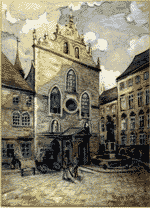|
Posted Thursday, September 5, 2002 Thursday, September 5, 2002 [images addes by this website]
Hitler's artwork and influence on display at Williams College WILLIAMSTOWN, Mass. (AP) -- The images of Adolf Hitler's Third Reich forever will be linked with evil. The menace of the swastika, the perfect but intimidating columns of marching Nazi soldiers. An exhibit at Williams College Museum of Art argues that it wasn't a study of warfare, politics and military strategy that influenced the background and symbols for Hitler's visions. It was art: Wagner's operas; the dark and simple work of German painters; Viennese architecture. "Prelude to a Nightmare: Art, Politics, and Hitler's Early Years in Vienna 1906-1913" traces the dictator's artistic aspirations, disappointments and influences during his seven years in the Austrian city. The exhibit uses about 275 paintings, posters and clips of film from Nazi rallies to illustrate art's influence on Hitler. Displays of anti-Semitic pamphlets that circulated around Vienna in the early 1900s show that Hitler mimicked the pamphlets for his own propaganda decades later.
A friend encouraged him to sell his paintings -- mostly postcards and watercolors of Vienna landscapes -- some of which are displayed in the Williams exhibit. According to a memoir kept by the friend and on display at the exhibit, some of Hitler's highest paying and most loyal customers were Jews. His work never rose to critical acclaim. "He was known for copying from other images," said Deborah Rothschild, the curator who organized the Williams exhibit. "He had no originality." While living the life of a struggling artist, Hitler was drawn to the politics of the pan-German party, a right-wing, anti-Semitic group that promoted the so-called superiority of an Aryan race. The artwork embraced by the pan-Germans -- folksy paintings that asserted German dominance -- was among Hitler's favorite. He railed against modern art. As Führer, Hitler staged an art show of "degenerate art," comparing works by artists such as van Gogh and Picasso to images of human deformity. The Williams exhibit, mostly strung together with pieces on loan from museums in Vienna, shows original works and reproductions of the art to which Hitler responded. There are the images he loved -- like the painting of drunken monks by Eduard von Grutzner -- and those he loathed, including a self-portrait of Vincent van Gogh. "His taste was very conservative," Rothschild said. "He had an ideal of what art should be, and he hated what didn't fit that ideal."
"He loved Wagner," Rothschild said. "He loved the timing, the presentation and the design." Wagner's set designer, Alfred Roller, had an obvious influence on Hitler. "Prelude to a Nightmare" juxtaposes scenes from Wagner's operas against photos of rallies orchestrated by the dictator. A painting of Roller's set design for "Rienzi" shows smoke and fire rising from Rome's capitol. The image is displayed next to a photograph of a Nazi night rally held in 1934 with smoke and fire set against large buildings. A set design from "Parsifal," with imposing, high arches and thick columns, mirrors an image of a swearing-in ceremony for Hitler's body guards. "You look at this, and you see where Hitler got some of his ideas," said Sherwin Fink, a business owner from Hillsdale, N.Y., who visited the exhibit Tuesday. "It gives a different perspective on someone we know a lot about." Rothschild designed the exhibit, which runs through Oct. 27, as part of a project highlighting art from Vienna being sponsored by 11 Berkshire galleries and museums. "As a college museum, I wanted something that would be a catalyst for thinking and discussion," she said. "I wanted to give people something to talk about." About 21,000 people have visited the exhibit since it opened in July, but Rothschild said despite the turnout, there are no plans to put it on tour. On the Net: http://www.williams.edu/WCMA/
|

